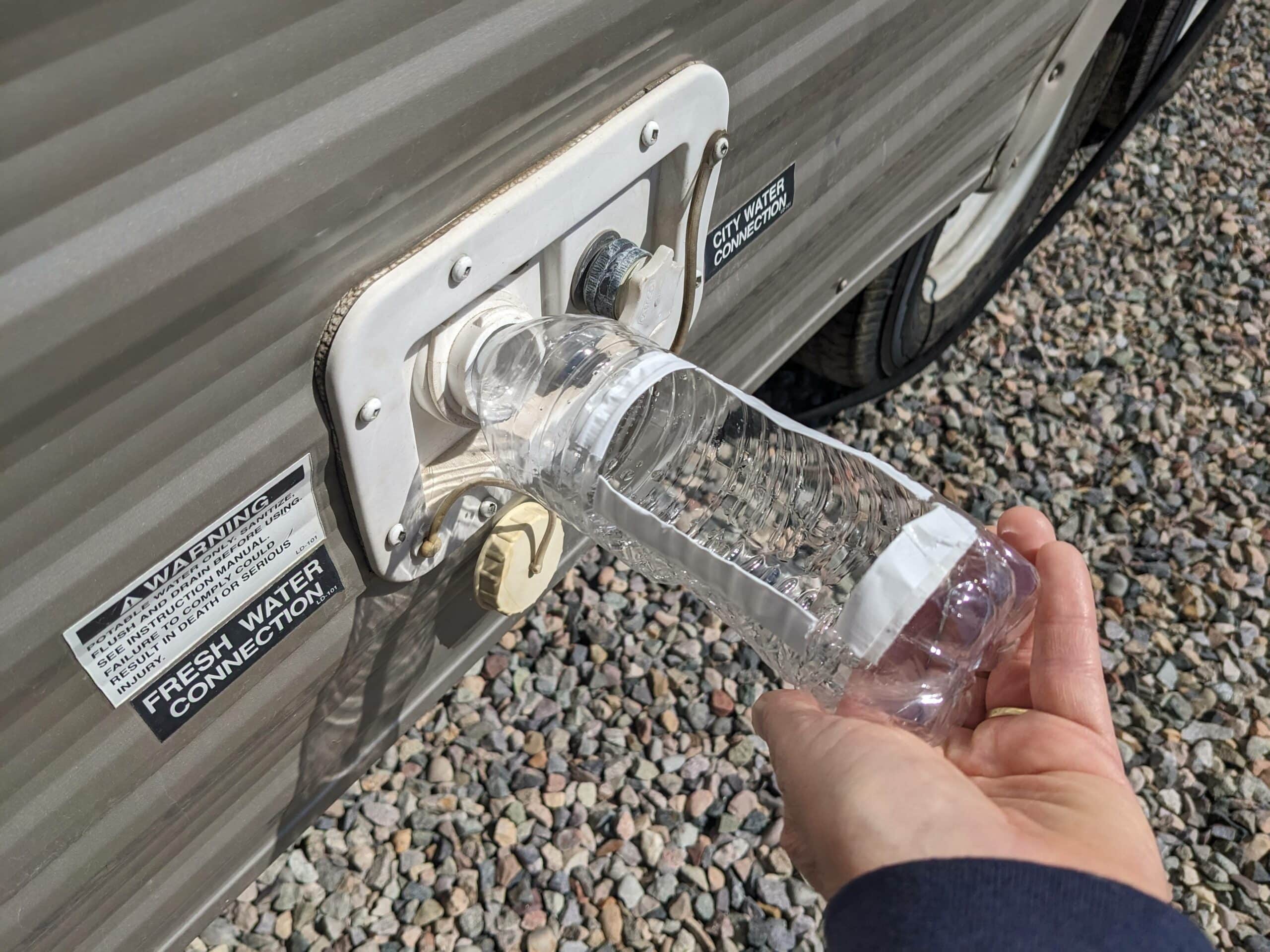To fill up your RV’s fresh water tank, connect a clean hose to a potable water source and your RV’s intake valve. Turn on the water and monitor the tank’s level until full.
Traveling in an RV provides freedom and flexibility, but maintaining your vehicle is crucial. One essential task is filling the fresh water tank. This ensures you have a reliable water supply for drinking, cooking, and cleaning during your trip. Knowing the correct process to fill your tank can save you time and prevent potential issues.
It’s important to use clean, potable water and regularly monitor your tank’s water levels. Proper maintenance of your fresh water tank guarantees a comfortable and worry-free RV experience.

Credit: escapees.com
Preparing For The Task
Before you fill your RV’s fresh water tank, preparation is key. Proper preparation ensures a smooth and efficient process. This guide will help you gather supplies and find a water source.
Gather Necessary Supplies
Gathering the right supplies is crucial. Here is a list of items you need:
- Fresh water hose: Use a hose designed for drinking water.
- Water pressure regulator: Protects your RV’s plumbing system.
- Water filter: Ensures clean and safe water.
- RV water tank filler: Helps to fill the tank without spilling.
- Gloves: Keeps your hands clean and dry.
Find A Suitable Water Source
Next, locate a safe and clean water source. You can use:
- Campground water hookups: Most campgrounds offer these.
- Public water fill stations: Found at rest areas and gas stations.
- Home water source: Use your home’s hose bib.
Ensure the water is potable. Avoid using water sources that are unsafe.

Credit: www.youtube.com
Locating The Fresh Water Tank
Filling your RV’s fresh water tank starts with knowing where it is. Properly locating the tank is crucial for a smooth and efficient process. This section will guide you on how to locate your RV’s fresh water tank.
Check Your Rv’s Manual
Your RV’s manual is the best place to start. It contains detailed information about your RV, including the location of the fresh water tank. Look for a diagram or section labeled “Water System” or “Plumbing.”
If you don’t have the manual, try finding it online. Most manufacturers offer digital copies. Knowing your RV’s make and model can help in this search.
Identify Access Points
Once you know the general area, you need to find the access points. These are usually outside the RV. Look for a small compartment labeled “Fresh Water Fill” or something similar.
Access points might also be inside the RV. Check under the bed, in the bathroom, or near the kitchen sink. These locations often house water systems and storage tanks.
| Location | Possible Access Point |
|---|---|
| Outside | Small compartment labeled “Fresh Water Fill” |
| Inside | Under the bed |
| Inside | In the bathroom |
| Inside | Near the kitchen sink |
Finding the fresh water tank and access points makes filling easier. Always refer to your RV’s manual for the most accurate information.
Ensuring Water Safety
Water safety is crucial for your RV trips. Clean water keeps you healthy. This section guides you on how to ensure water safety.
Use A Water Filter
Using a water filter is essential. It removes harmful particles. Always attach a filter to your water hose.
Filters help in removing:
- Dirt
- Rust
- Other contaminants
Choose a filter with a good rating. Replace it regularly. Check the filter’s instructions for replacement frequency.
Sanitize The Tank
Sanitizing the tank kills bacteria. It keeps the water clean. Follow these steps to sanitize your tank:
- Drain the tank completely.
- Mix one cup of bleach with one gallon of water.
- Pour the mixture into the tank.
- Fill the tank with fresh water.
- Let it sit for 12 hours.
- Drain and rinse the tank several times.
Regular sanitization is key. Do this at least once every six months.
Connecting The Hose
Connecting the hose to fill your RV’s fresh water tank is crucial. This process ensures a steady supply of clean water for your trip. Follow these steps to connect the hose properly.
Attach To Water Source
First, locate a clean water source. This could be a spigot at a campground or a city water hookup. Ensure the water is safe for drinking.
- Use a food-grade hose to avoid contamination.
- Attach one end of the hose to the water source.
- Turn on the water slightly to flush out any debris.
Flushing the hose prevents dirt from entering your RV’s tank.
Secure To Rv Inlet
Next, find your RV’s fresh water inlet. This is usually marked clearly. Attach the other end of the hose to this inlet.
- Ensure a tight connection to avoid leaks.
- Turn on the water slowly to fill the tank.
- Monitor the fill level to prevent overfilling.
Overfilling can cause water to spill and create a mess.
Using these steps, you can efficiently fill your RV’s fresh water tank. Enjoy a steady supply of clean water on your adventures.
Filling The Tank
Filling your RV’s fresh water tank is a crucial task. It ensures you have clean water on the go. Follow these simple steps to get the job done.
Turn On The Water
First, connect your water hose to a clean water source. Make sure the hose is free from dirt and debris. Attach the other end of the hose to the water inlet on your RV. Turn on the water slowly to avoid pressure surges. Ensure the water flows smoothly into the tank.
Monitor The Tank Level
Keep an eye on the water level in your tank. Many RVs have a built-in water level indicator. Use this to monitor the filling process. If your RV does not have this feature, listen for any overflow sounds. Check the tank visually if possible.
Tips for Monitoring:
- Use a flashlight to check the tank level.
- Stop filling when the water reaches the fill line.
- Avoid overfilling to prevent leaks.
By following these steps, you will have a full, clean water tank ready for your next adventure. Enjoy your travels with the peace of mind that comes from proper water management.
Checking For Leaks
When filling up your RV’s fresh water tank, checking for leaks is crucial. Leaks can cause significant damage and costly repairs. Regular inspection ensures the safety and efficiency of your water system.
Inspect Connections
First, inspect all connections. Ensure they are secure and not loose. Loose connections are a common source of leaks. Use a wrench to tighten any loose fittings.
Look at the hose connections and the fittings on the tank. Check the hose clamps to make sure they are tight. Replace any worn-out or damaged clamps immediately.
Look For Drips
Next, look for drips around the tank and hoses. Drips can indicate a leak. Use a dry cloth to wipe down the connections. Then, watch for any moisture.
If you see any water, you have found a leak. Mark the spot and repair it right away. Ignoring drips can lead to larger problems.
To make this process easier, you can use a leak detection solution. Apply the solution to the connections and look for bubbles. Bubbles indicate a leak.
| Inspection Point | Action |
|---|---|
| Hose Connections | Tighten or replace |
| Tank Fittings | Check for wear and tear |
| Hose Clamps | Ensure they are secure |
Finalizing The Process
Once your RV’s fresh water tank is full, it’s crucial to finalize the process correctly. This ensures your water supply remains clean and your equipment stays in good condition. Follow these steps to complete the task efficiently.
Turn Off The Water
First, turn off the water supply. This stops water from overflowing and creating a mess. If you used a water pump, switch it off.
Make sure the pump is completely off to prevent damage. Check the water flow has stopped before moving on.
Disconnect The Hose
Next, disconnect the hose from the RV’s water inlet. Do this carefully to avoid spilling water.
Drain any remaining water from the hose. Coil it neatly to store away. Proper storage keeps your hose in good condition for future use.
StepActionReason1Turn off water supplyPrevent overflow2Switch off water pumpProtect equipment3Disconnect hoseAvoid spills4Drain and store hoseMaintain hose condition
By following these simple steps, you ensure your RV’s water system stays efficient. A properly filled and maintained fresh water tank is essential for a comfortable RV experience.
Maintaining The Fresh Water System
Keeping your RV’s fresh water system clean is essential. This ensures safe drinking water and a healthy lifestyle on the road. Follow these steps to maintain your RV’s fresh water system.
Regular Cleaning
Regular cleaning of your fresh water tank is vital. Use a mild bleach solution to disinfect the tank. This prevents bacteria buildup and keeps your water safe. Follow these steps for effective cleaning:
- Mix one cup of bleach with a gallon of water.
- Pour the solution into the tank.
- Fill the tank with fresh water.
- Run the water through all faucets until you smell bleach.
- Let it sit for 12 hours.
- Drain and rinse the tank thoroughly.
Periodic Inspections
Perform periodic inspections of your fresh water system. Look for leaks, corrosion, and wear. Check the water pump and hoses for any damage. Replace any faulty parts immediately. Inspect the water filter and replace it as needed. This ensures clean water flows through your system.
| Inspection Task | Frequency |
|---|---|
| Check for leaks | Monthly |
| Inspect hoses | Every three months |
| Replace water filter | As needed |
| Inspect water pump | Every six months |
Maintaining your RV’s fresh water system ensures a safe and enjoyable trip. Keep it clean and inspect it regularly to avoid issues.
Filling up your RV’s fresh water tank is easy with the right steps. Follow these guidelines to ensure a smooth process. Always prioritize cleanliness and safety when handling water. Enjoy your travels with a fully stocked fresh water tank. Happy camping and safe travels!
FAQs:
How Do I Fill My RV’s Fresh Water Tank?
To fill your RV’s fresh water tank, locate the fill port, attach a clean hose, and start filling. Monitor the water level to avoid overfilling. Ensure the water source is safe and clean.
Can I Use a Regular Garden Hose?
Yes, you can use a regular garden hose, but it’s better to use a drinking water-safe hose to avoid contamination. Ensure the hose is clean before use.
How To Prevent Overfilling The Tank?
To prevent overfilling, monitor the water level closely or use an automatic shut-off valve. Stop filling once the tank is full.
Is It Safe To Drink Water From RV Tank?
Yes, it’s safe if you use a clean hose and fill from a safe water source. Regularly sanitize the tank to ensure water quality.
